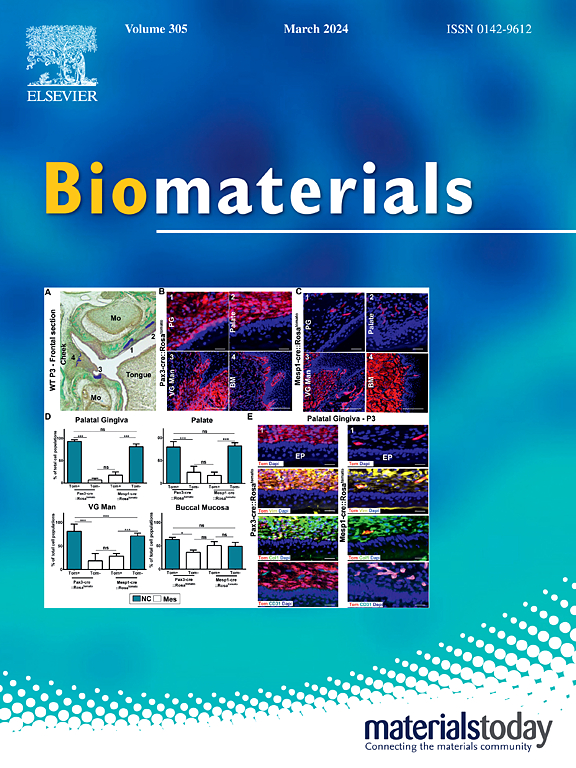Efficient organic nanoparticles for photothermal antibacterial activity and immune regulation to promote maxillofacial wound healing and scarless repair
IF 12.9
1区 医学
Q1 ENGINEERING, BIOMEDICAL
引用次数: 0
Abstract
Treating maxillofacial infections is hindered by severe inflammation and bacterial biofilms, which delay healing and often result in significant scarring. Photothermal therapy (PTT), which utilizes a photothermal agent (PTA) to generate localized heat, presents a promising approach that effectively eliminates pathogens while minimizing tissue damage, thereby enhancing treatment safety and efficacy. However, challenges such as low photothermal conversion efficiency and biocompatibility issues persist. In this study, we developed hemin chloride-modified organic small molecule-based nanoparticles (PTA@Hemin NPs). This material demonstrates exceptional photothermal effects with 81 % photothermal conversion efficiency and excellent biocompatibility. Under near-infrared (NIR) laser irradiation, the PTA@Hemin NPs generate strong photothermal effects, which synergize with the inherent antibacterial properties of hemin to significantly enhance the eradication of free bacteria and biofilms. Furthermore, PTA@Hemin NPs effectively scavenge reactive oxygen species (ROS) and alleviate inflammation by downregulating the expression of pro-inflammatory factors such as Cd86 and Il-1α, reducing M1 macrophage polarization. Both in vitro and in vivo experiments confirmed that PTA@Hemin NPs significantly enhance antibacterial and anti-inflammatory effects, while facilitating scarless healing of maxillofacial wounds in mice. These results highlight the potential of PTA@Hemin NPs as a highly effective strategy for treating bacterial infections, particularly those involving biofilms, in future clinical applications.
有效的有机纳米粒子光热抗菌活性和免疫调节,促进颌面部伤口愈合和无疤痕修复
严重的炎症和细菌生物膜阻碍了颌面部感染的治疗,这会延迟愈合并经常导致显著的疤痕。光热疗法(PTT)是一种利用光热剂(PTA)产生局部热量的有前途的方法,它可以有效地消除病原体,同时最大限度地减少组织损伤,从而提高治疗的安全性和有效性。然而,诸如低光热转换效率和生物相容性问题等挑战仍然存在。在这项研究中,我们开发了氯化血红素修饰的有机小分子纳米颗粒(PTA@Hemin NPs)。该材料具有优异的光热效应,光热转换效率高达81%,具有良好的生物相容性。在近红外(NIR)激光照射下,PTA@Hemin NPs产生强烈的光热效应,与血红蛋白固有的抗菌特性协同作用,显著增强对游离细菌和生物膜的清除能力。此外,PTA@Hemin NPs通过下调促炎因子如Cd86和Il-1α的表达,减少M1巨噬细胞极化,有效清除活性氧(ROS),减轻炎症。体外和体内实验均证实PTA@Hemin NPs显著增强抗菌和抗炎作用,同时促进小鼠颌面部伤口无疤痕愈合。这些结果突出了PTA@Hemin NPs在未来临床应用中作为治疗细菌感染,特别是涉及生物膜的细菌感染的高效策略的潜力。
本文章由计算机程序翻译,如有差异,请以英文原文为准。
求助全文
约1分钟内获得全文
求助全文
来源期刊

Biomaterials
工程技术-材料科学:生物材料
CiteScore
26.00
自引率
2.90%
发文量
565
审稿时长
46 days
期刊介绍:
Biomaterials is an international journal covering the science and clinical application of biomaterials. A biomaterial is now defined as a substance that has been engineered to take a form which, alone or as part of a complex system, is used to direct, by control of interactions with components of living systems, the course of any therapeutic or diagnostic procedure. It is the aim of the journal to provide a peer-reviewed forum for the publication of original papers and authoritative review and opinion papers dealing with the most important issues facing the use of biomaterials in clinical practice. The scope of the journal covers the wide range of physical, biological and chemical sciences that underpin the design of biomaterials and the clinical disciplines in which they are used. These sciences include polymer synthesis and characterization, drug and gene vector design, the biology of the host response, immunology and toxicology and self assembly at the nanoscale. Clinical applications include the therapies of medical technology and regenerative medicine in all clinical disciplines, and diagnostic systems that reply on innovative contrast and sensing agents. The journal is relevant to areas such as cancer diagnosis and therapy, implantable devices, drug delivery systems, gene vectors, bionanotechnology and tissue engineering.
 求助内容:
求助内容: 应助结果提醒方式:
应助结果提醒方式:


